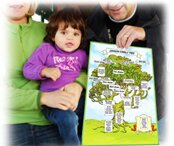|
|||||||||||||||||||||||||||||||||||||
|
|
|
|



|
|||||||||||||||||||||||||||||||||||||
|
|
|
|



PRINTABLE FAMILY TREE
Genealogy is the science that deals with check by documents and reconstruct the family ties that exist between members of one or more families.
Genealogical research, like any other scientific body that wants to achieve certain results, and, as such, verifiable, is accomplished through the development of an approach, based on interdisciplinary knowledge in the specific case that blends experience in a systematic way of a historical- social, legal and archival (family law), and socio-linguistic (onomastics) and history of writing (palaeography), provide tools to find, read, understand and contextualize the sources.
The outcomes of this activity can be represented through the use of certain media, paper and / or computer, such as the family tree, equivalent to a graphical representation of the different generations and branches of the same strain on family having a common ancestor. The term extension is used in common parlance as a synonym for race. [1] [2]
Index
[Hide]
1 The relations of kinship and the counting of degrees
2 The subject of genealogical research
3 General methodology of genealogical research
4 Typical Problems
5 History
6 Sources archival
7 Bibliography
8 See also
9 Free Software
10 more projects
11 External links
12 Notes
The family relationships and the calculation of degrees [edit]
There are three types of kinship between members of one or more families:
Kinship: the "relatives" of a subject, are all those people who, like him, descended from his own parent.
Affinity: the "related" to a subject are all relatives of your spouse (or affinity of each spouse are not related to each other).
Relevance: The relevance of relationships are those that connect a person with all the other people of another family, linked to yours with a wedding.
There should also be noted that the spouses do not fall into any of these categories as related by marriage relationship.
From the point of view the counting of degrees of family relationship is also carried out according to the criteria laid down in Articles 74, 75, 76 of the Civil Code. In order to calculate the actual relationship between two components of a particular family group in the collateral line is we must go the distance, by generation, pass from one of the subjects taken into account, going back to the common parent (excluding the latter from the calculation) and then descending to the second subject. Hence we have:
2 º degree, brothers and sisters;
Stage 4, cousins (children of brothers).
In a straight line there are as many degrees as there are generations, excluding the frame. Hence we have:
2 nd grade, grandfather and grandson.
According to Article 77 of the Civil Code, the law does not recognize the bond of kinship beyond the sixth grade, except for some effects especially determined. This of course does not eliminate the biological and genealogical kinship between people with a higher degree of relatedness to the sixth.
For the church order the calculation is performed in the same way, according to the criteria of the canons 108-109 of the Code of Canon Law, "in line there are as many degrees as the generations, ie how many people, counting the common ancestor, in line oblique many degrees as there are people on both lines together, not counting the common ancestor. " Hence we have:
2 º degree, brothers and sisters;
Stage 4, cousins (children of brothers);
2 nd grade, grandfather and grandson.
The subjects of genealogical research [edit]
The subjects of genealogical research are: the ascendants, descendants, collateral, in-laws, the related.
The ancestors are ancestors, ie all persons from whom a person descends by way of generation.
The descendants are all individuals who come through successive generations, from a given subject.
The reactions are all descended from a common ancestor, other than in a straight line.
In-laws are all relatives of the spouse.
The people are all related to a family, than people of another family, this genealogically connected with a marriage.
General methodology of genealogical research [edit]
The genealogical research provides a methodology, divided into four stages, which must be followed in a systematic way. First, you scan the documents providing information on pedigree (dates of birth, death, baptism, marriage and their names), by searching in the archives of the civil state, parish or state. Next, we derive the data of genealogical interest and proceeds to processing: data classification and construction of various lines of ancestry and descent. Finally, we draw up a text, which describes the methods used during research and sources consulted, which also includes a genealogical chart on which are reproduced the results obtained.
During the research the genealogist may face several problems, which often are caused by the lack of genealogical data relating to subjects of interest. These problems may be caused by many factors, such as intentional or accidental destruction of documents (fires to prevent the spread of contagious diseases, wars, revolutions, natural deterioration of the documents), lack of formal institutions and legal systems regarding the demographics of population (marital status, registration, etc.). Surely the time factor is what most affects genealogical research. In fact, the availability of sources is very different depending on the age in which he lived to study the subject and his family.
Typical problems [edit]
The path, which leads the genealogist to the identification of subjects and relationships, and the construction of the family tree of family strain, is not without obstacles. The problems are essentially four:
uncertainties of date;
variations of the name;
uncertainties of relationship and homonyms.
uncertainties about reading content in languages and / or unusual records;
These problems can occur in varying degrees, depending on the amount of genealogical data that has managed to collect. However, the collection of genealogical data requires a search of the sources (public and private) that do not always lead to satisfactory results, due to the lack of genealogical data present.
History [edit]
Sketch History
This entry on the topics history and law is only a draft.
Please help improve conventions of Wikipedia. Follow the suggestions of the reference projects 1, 2.
Sketch law
The practice of genealogy has very deep roots. The Bible, for example, contains the genealogies of the patriarchs and kings of Israel and the priests held a genealogy to ensure the priesthood granted only to the sons of Levi. The Jews were not the only ones to record genealogies, we find traces of this practice among the ancient Egyptians, Greeks and Romans.
Among the Bedouin Arabs knowledge of their genealogy (ansab) was a title of particular excellence and luster. Among the inscriptions thamudene, for example, the Nasab (bond of filiation, introduced from the Arabic word ibn, meaning "son of", or bint, or "daughter") you could stretch back for over ten generations. The longest recorded as many as 14 generations previous to the present name on inclusion.
With Islam, the almost total sedentary Arabs did decrease somewhat this study, although it was still practiced, as successive generations of those early Muslims (often not even Arabs) had great interest in knowing all of you " first "(awa ʾ il) to convert to Islam.
The science of genealogy has therefore played a key role in tracing the early history of Islam, indirectly, so that a proverb asserts that Islam will survive as long as it is preserved and particata "knowledge of ansab".
It will be only in recent times that for example in Turkey's founder and first president of the Turkish Republic, Mustafa Kemal Atatürk, will introduce the adoption of family names as regular as was customary in the Western world.

The family tree is usually a full list of ancestors, or more specifically, a chart used in genealogy to show family relationships between individuals.
Usually the tree is built using the boxes, circular and square for males and females, containing the names of each person, often accompanied by additional information such as date and place of birth and death, in some cases entering employment or profession. These symbols are arranged from top to bottom in chronological order, are connected by lines representing different types of marriages and extramarital unions and the offspring.
Some restrict the use of the term to indicate only the patrilineal descent, although in common usage the term is also used more generally.
In some cases, for example, if you can not insert a chart, you can describe the ancestors of a person using a genealogical chart.




